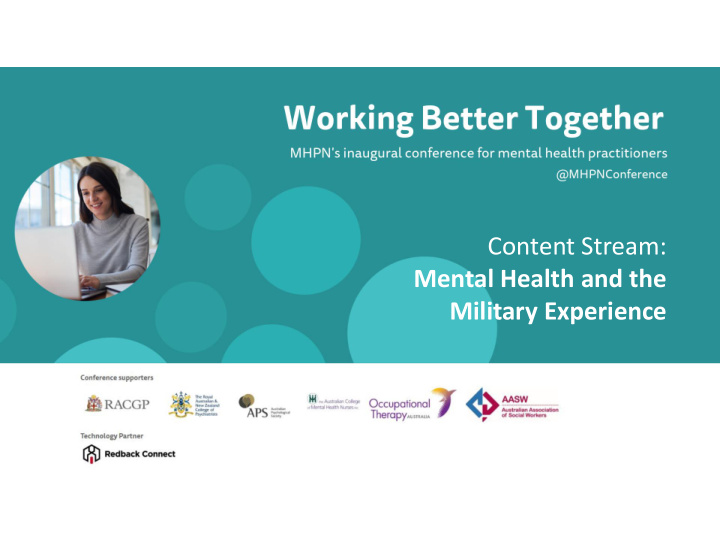



Content Stream: Mental Health and the Military Experience
Webinar DATE: Making Sense of Veteran Mental November 12, 2008 Health Presentations 6 pm – 7 pm AEST Tuesday 28 May 2019 Supported by The Royal Australian College of General Practitioners, the Australian Psychological Society, the Australian College of Mental Health Nurses and The Royal Australian and New Zealand College of Psychiatrists
PAGE 3 Tonight’s panel Dr Phil Parker Ms Kristi Heffernan Dr Jon Lane General Practitioner Psychiatrist Clinical Psychologist Audience tip: Click the ‘Open Chat’ tab at the bottom right of your screen to chat with other participants. NB: chat will open in a new browser window. Facilitator: Ms Nicole Sadler Clinical Psychologist
PAGE 4 Ground Rules To ensure everyone has the opportunity to gain the most from this live event please: • Be respectful of other participants and panellists: behave as you would in a face-to-face activity. • Interact with each other via the chat box . As a courtesy to other participants and the panel, please keep your comments on topic. Please note that if you post your technical issues in the participant chat box you may not be responded to. • Need help? Click the technical support FAQ tab at the top of your screen. If you still require support, call the Redback Help Desk on 1800 291 863. • If there is a significant issue affecting all participants, you will be alerted via an announcement. Audio issues? Listen on your phone by dialling this phone number 1800 896 323 Passcode: 1264725328#
PAGE 5 Learning outcomes This informal panel discussion will provide ‘insider’ insights to the military experience shared by qualified mental health clinicians who have had direct experience serving in the Australian Defence Force (ADF). At the conclusion of this interactive and dynamic session participants will have: • Improved insights of how and why the experience of military culture may impact on veterans’ mental health • Improved insights to the meaning/stories behind somatic and mental health presentations of veterans • Increased confidence to engage in conversations with veterans about the ‘meaning behind their story’ Supporting resources are in the library tab at the bottom right of your screen.
PAGE 6 What do we know about the veteran population in Australia? There are approximately: • 58,200 current serving ADF personnel • 641,00 living Australian veterans • 5,000 ADF personnel transition • 165,000 veterans in Australia out of the full-time military each receiving DVA benefits year • 320,000 veterans who have been deployed AIHW Profile of Australian Veterans 2018
PAGE 7 What do we know about the mental, physical and social health of contemporary veterans? • Most discharged at their own request • 20% were medically discharged • 3% non-voluntary administrative discharge • 84% engaged in some purposeful activity (employment / studying) – 62.8% in civilian employment • Most commonly reported reasons for transition: – ‘impact of service life on family’ (10.2%) – ‘better employment prospects in civilian life’ (7.2%) – ‘mental health problems’ (6.5%) – ‘physical health problems’ (4.3%) Transition and Wellbeing Research Programme: Mental Health Prevalence and Pathways to Care, 2018
PAGE 8 What do we know about the mental, physical and social health of contemporary veterans? Those transitioning from full-time ADF service at particular risk for mental disorder: • Almost three in four met criteria for a lifetime mental disorder • Almost half met criteria for a mental disorder in the past year • Particular risk for those discharged medically • Substantial number with sub-threshold symptoms which can be a precursor of later disorder • Many of those who met criteria for a 12-month mental disorder were not medically discharged and / or were not DVA clients • Increase in risk from one year post-transition Help seeking rates are consistent with other military and veteran populations and significantly better than community rates • But need to improve the number receiving evidence-based treatments
PAGE 9 Estimated prevalence of 12-month ICD-10 disorder in Transitioned ADF
PAGE 10 What do we know about the mental, physical and social health of contemporary veterans? • In 2001 – 2016 there were 373 certified suicide deaths among people with at least 1 day of ADF service since 2001. • Ex-serving men had an age-adjusted suicide rate 18% higher than for all Australian men. • The age-adjusted suicide rate was lower for current serving and men in the Reserves than for all Australian men. • Ex-serving men aged under 30 had a suicide rate 2.2 times that of Australian men the same age. AIHW study on suicide in serving and ex-serving ADF members: 2018 update
Centenary of Anzac Centre Practitioner Support Service • Our aim is to improve the lives of Australian veterans with mental health problems by supporting the practitioners and organisations who work with them – Free national service – Access to advice and support from multidisciplinary panel of experts – Online resources – Provide professional development and networking opportunities through outreach.
PAGE 12 Thank you for attending. Visit www.mhpnconference.org.au to post your comments or questions about veteran mental health presentations in the forum associated with this activity. Next week’s activity: Comorbid Mental Health Conditions in Veterans: Strategies for assessment, case formulation and treatment Tuesday 4 th June 2019 at 7.15 pm AEST
PAGE 13 Thank you! Don’t forget to complete the survey feedback Click the survey feedback tab at the top of your screen to open the survey.
Recommend
More recommend